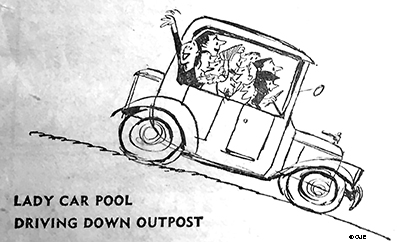Note from Linda: At the time of this article, February 7, 1957, the lead-in stated the following: “Chuck Jones has been Art Director of the Crier from its infancy, and herein tells you how come. He and Dottie dwell in a fabulous glass-and-stone aerie up in Hollywood Knolls, and Little Linda is all grown up and married.” I was, as stated in the article, seven years old in 1944. We had a beautiful, big yellow tom cat named Passmore (yes, named after the street we lived on). One day I asked my parents, “If Passmore had kittens, could we have one?” Of course, their answer was that Passmore was a tom cat and therefore could not have kittens. I said, “But IF he had kittens, could we have one?” With a knowing glance at each other, they agreed. I took them across the street to our neighbor’s black cat who had just had five adorable little yellow kittens…Yes, I got not only one, but two…I named them Rudy and Bennie…Here is Part III.[PART III] House with Long Haul
I decided to employ logic. Even if I lost with Dottie, I might impress Linda. I indicated with patient yet pointed logic that the two miles to the nearest lady-ridge-resider ride-sharing intersection was Woodrow Wilson and Mulholland, while the nearest market was but a scant half mile from our home on Passmore Drive…and all down hill, including one hundred and eighty-seven steps connecting our street with steps connecting our street with the one below. Furthermore it would take a full day’s supply of gas in our gasping Oldsmobile to struggle up Woodrow Wilson to Mulholland and share in the economies of the ridge girls in their gay junkets to Finkle’s market at Highland and Franklin.
She had gained confidence through my maunderings and gently exhaling a fragrant cloud of rum, maple and tobacco, said that down-hill empty-handed became up-hill grocery laden, that the one hundred and eighty steps was a farce going down with gravity as a friend, but became an endless cement ladder going up, laden with salmon, Spam, short-ribs, and such. Furthermore the steps were dangerous; behind a fence paralleling the last fifty feet lived a psychotic Doberman Pinscher, a reject from the Canine Corps—who in being taught to bite enemy soldiers had carried instructions a step further and now bit anything. He had gnawed a head-sized hole out of his chain link fence, and travelers on the steps could only avoid the action of his garbage-disposal jaws by wading through a breast-high orchard of greasy poison oak opposite him. When Linda was with her, she had to carry her—and the groceries—over her (Dottie’s) head. All this she was willing to endure, she said, but in her illogical woman’s way she just couldn’t see what having poison oak, hydrophobia, and a weakened hearts was doing to further the war effort.
[Come back next week for part IV!]




